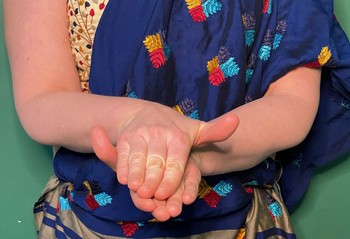Nṛttaratnāvalī: Saṃyuta Hasta (Double Hand Gestures)
1200 CE - 1300 CE - by Jāya Senāpati
Saṃyuta Hasta - Double Hand Gestures
Nṛttaratnāvalī - Language: Sanskrit
The Nṛttaratnāvalī by Jāyana (also called Jāya Senāpati) is in Sanskrit, and written down in Telegu text. It dates from the Kātatīya Dynasty, which covered what is now modern day Telegana. The rulers where worshippers of the goddess Kātatī and this was a golden age for the region, with a lot of writing on the arts and other intellectual concepts. Jāyana wrote 3 texts on dance, however the Nṛttaratnāvalī is the one that survives. The Gītaratnāvalī and Vādyaratnāvalī did not survive. The work divides itself into 8 chapters - 4 devoted to marga - the classical format that traces to the long linneage of historical treatises, and 4 desi dance which isn't within this cannon and is generally described as regional and popular, which the author then describes meticulously. This kind of division starts at this time period.
Descriptions and Meanings
2:172
If the palms of the pataka hands are joined, it is añjali.
2:172
This is used in salutation. When saluting Brahmins the hands are placed near the chest, to the giver near the forehead and to gods above the head. But this rule does not apply in anger and mirth.
2:178
If the two sarpaṡīrsha hastas are held in such a way that the sides of the hastas touch (they face each other), it is kapota hasta.
2:178
It finds usage talking to gurus and humility. If it is placed in front of the chest and made to face forward, while talking to gurus, depicts politeness.
2:179
Women must make it tremble for this purpose. It is used to depict fear and shivering due to cold. This gesture is like the tortoise and so has been kurmaka by some.
2:175
When the hastas change to arālas in this position and are moved to the left, it becomes svastika hasta as sage Bharata saw it.
2:176
Men depict long objects, forest, high objects, earth, amplitude, clouds, sky, etc by separating the hands. Women must depict this with pataka hastas.
2:189
Two sarpaṡīrsha are held in such a way that the outer edge of the little fingers and the metacarpus (the hand from the wrist to the root of fingers) of both hands are brought together. This is said to be puṣpapuṭa. .
2:189
It is used in begging, offering to gods, holding flowers, water, grains and food.
2:184
If arala or sarpaṡīrsha hastas are crossed at the wrists and placed so that the right hand is on the left shoulder and left on the right shoulder, both hands facing the dancer, it is utsaṅga.
2:185
This is used to press hard, indignation, anger, touching the back (touching secretly), cold, hugging around the neck, jealousy and concealing the breasts.
2:173
If the kaṭakāmukha hastas are placed one over the other, crossed at the wrists, it is kaṭakāvardhamāna. A few scholars opined that the hands must be held facing each other.
2:174
This is used in acceptance of areca nut and leaf, and other erotic acts and in bowing at the piqued heroine’s feet.
2:187
The ṡukatunḍa hastas are bent slightly and held at the chest with the plams facing away from each other. The hands are turned and moved downwards slowly to face downwards. This is the avahittha hasta.
2:187
Emaciation, sigh and longing can be depicted with this.
2:186
When the sarpaṡīrsha hastas are placed between the shoulder and elbow, right hand on left arm and left on right arm, it is gajadanta hasta. .
2:186
Carrying weight, holding a pillar, uprooting and lifting a hill and the like can be depicted by using this.
2:180-181
The left hand holds the right elbow and musti hasta of the right hand is tucked into the left elbow. This is niṣadha.
2:181
This is used to hug the pillar, in fear, inquisitiveness, superior goodness or beauty, flatulence, steadiness, arrogance and intoxication.
2:192
Patāka hastas are placed one over the other from the wrist. The thumbs are raised and the other fingers are held separately to form the makara hasta.
2:193
A hunting leopard, snake, lion, crocodile and other acquatic animals, demon, flow of river, et al can be depicted with makara hasta.
2:190
When the haṁsapaksha hastas are turned away from each other, it is the vardhamāna hasta. .
2:190
If separated from a crossed position it can depict doors and opening windows.
2:191
When moved apart from proximity, it shows tearing the enemy’s chest, etc. other scholars opine that this hasta is to be held with sarpasirsa.












